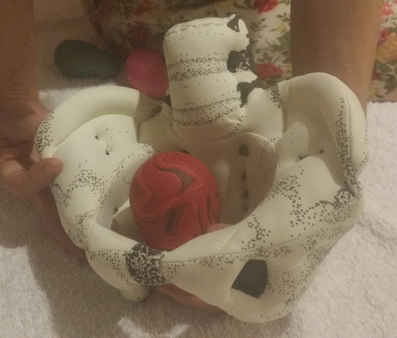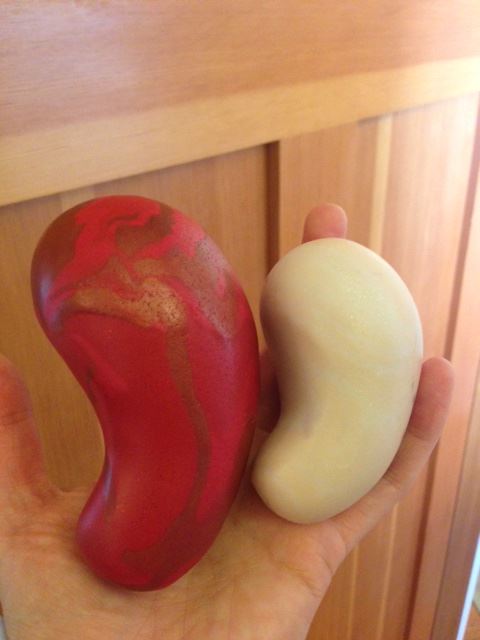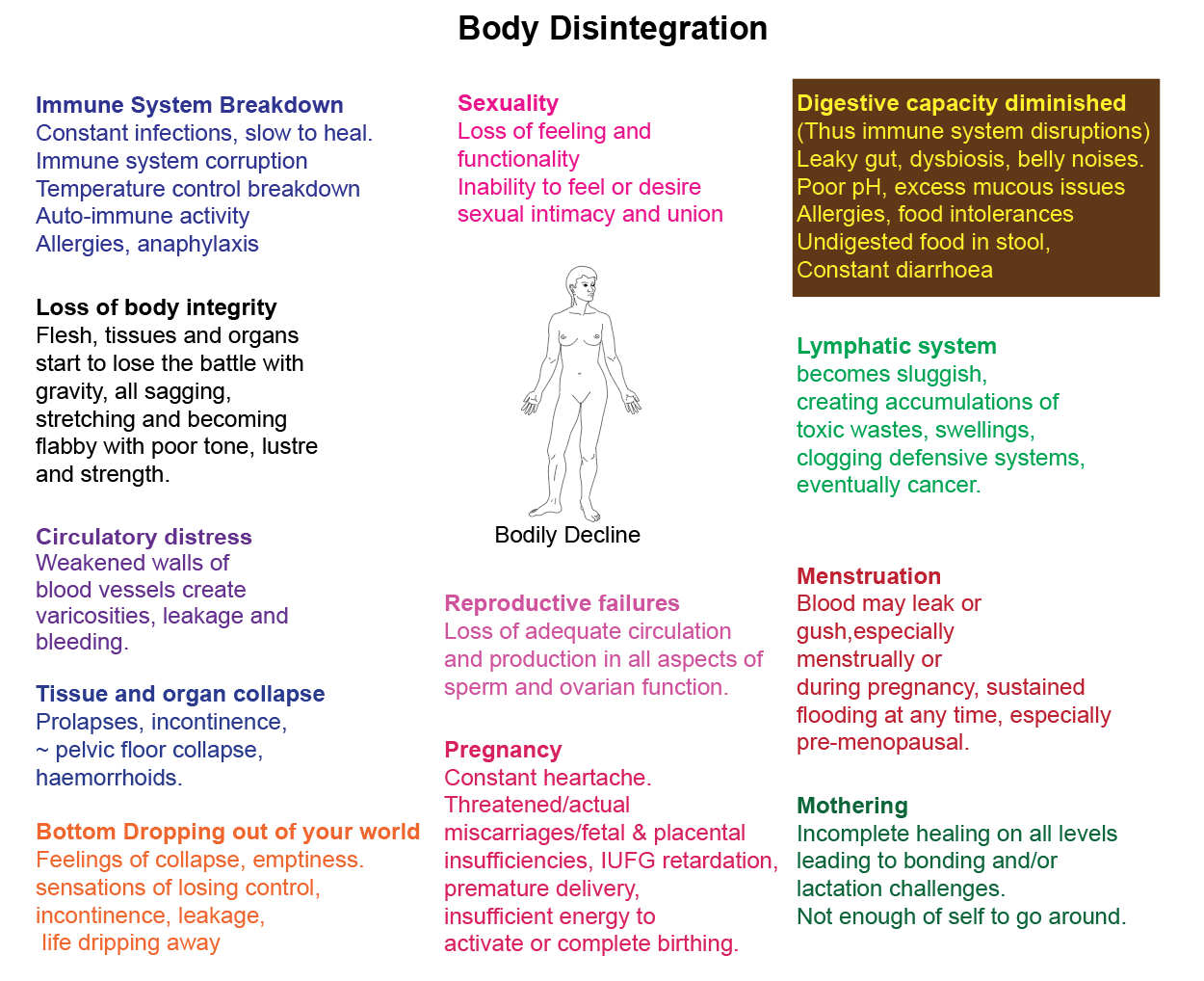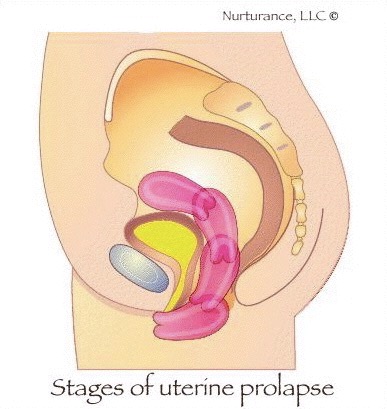Uterine (or any organ falling down) Prolapse
Many prolapses can be easily prevented, halted, and/or corrected with a little knowledge and support. It is important to take preventative measures and to act quickly to speed up healing if faced with a prolapse…

Uterus where she should be with a bleeding load on
(pre period)
Is usually half this size.
Thus not as obvious when she is positioned correctly .
When ‘busy’ making a potential baby nest – as she must ever month all through the reproductive years. .
Normal vs dropped . .

This is a healthy uterus and where we want it inside the body.
Ideally, a uterus is suspended by its many ligaments to be ‘sandwiched between the colon and bladder and sit perfectly in the center of one’s hips, slightly tilted over the bladder. With life, heavy lifting, gravity, and most commonly with childbirth, the next image shows what can start to happen to the uterus.
Red clay model – about to bleed size.
White model – normal size (of reproductive age).

Prolapse is defined as the falling forward or down of an internal organ. Usually this is in reference to either the bladder, colon, uterus or some combination of falling forward or down of one or more of these organs. My mother suffered from a bladder prolapse from my own birth – all her life.
Easily done – inconsiderate nursing practices and body collagen weakness
(Unfortunately also likely to have haemorrhoids/varicose veins and all things drifting south).
Elder wisdom led us to self help – if we listened. Oral traditions were all that existed – and learning at the mother’s knee was all that was granted through history.
Below is what tends to happen when we ‘know best’. Pretend we are the same all month – all ages – and that bleeding is of no consequence. Especially as women we we overdo anything. When leading up to a period (see extra uterus size above) or in pregnancy or after birth – we are not men and we have vastly extra body loads – when we do not take this in to consideration – our tissues/bodies breakdown – and prolapse is only one example.

There are four stages of uterine prolapse
The stages of prolapse are numbered from least severe to most from 1 to 4.
Stage 1: When the uterus has dropped just a tiny bit into the vaginal canal. Some women may not notice any symptoms at all. If a woman is sensitive or very in tune with her body she may notice a slight heaviness in the pelvic area and some pain. This is the most common symptom. Other women may feel an unpleasant ‘falling out’ feeling in the pelvic region, fearing something may literally fall out, though in this stage of prolapse, the uterus is still high inside the vaginal cavity.

Stage 2: The uterus has shifted down the vaginal canal about half-way down inside the vaginal canal. Most women will notice the above listed symptoms with more severity and discomfort. If the woman has a sexual partner, he or she will most certainly notice things are different.
Stage 3: The uterus has dropped all the way down to the very entrance of a woman’s vagina and is at the labia. ‘Something’ (the cervix of the uterus), is described as being present if the woman takes a look and may even poke out a little, however, the uterus is still mostly inside the body. A stage 3 uterus may be harder to correct with holistic means without considerable life alterations.
If the uterus position can be fixed without surgery (some women are able to correct this without surgical intervention) this will be a longer healing journey and will take diligence on the woman’s part. Even with effort, some of these stage 3 uterine prolapse women will not be able to completely correct this kind of prolapse. Do not use mesh!!
Getting a stage 3 to go back to a stage 2 or stage 1 prolapse requires diligence and stopping doing what created this. Whether a woman can correct this kind of prolapse depends on her habits and unique constitution. It is important to address any of the earlier stages of prolapse immediately, as the reason it is there also needs undoing. (See the disintegration diagram – you will have more happening – and it is not aging but neglect – of your body).
This rarely self corrects. The uterus may continue to travel down with time and gravity, if left to gravity and continual hope for it magicking itself back to normal.
Stage 4: This stage is the most severe. This is when the uterus has moved completely outside of the body. It is most likely to happen after not being respectful of self. Or a traumatic event that may have undone the Spleen Yang holding function. Possibly an exceptional long and difficult labour when someone is in a weakened collagen sate already. Labour is not in itself a reason to worry. Women should be resilient enough. If a woman has an experienced and competent birth attendant, who knows what to do – all will be well.
Mindfulness
The most common time a woman will experience prolapse is supposedly immediately after childbirth. It doesn’t matter how young or old she is. Even a Caesarian birth can lead to prolapse because the uterine ligaments are still stretched during the growth of a baby and the baby being pulled out often takes force. Note that I’ve also treated patients who have suffered prolapse from particularly forceful and insensitive doctors doing routine exams or biopsies – the pelvis and uterus should always be treated with respect by you and others!
A mild, prolapse is considered normal immediately after labour. Gift all pregnant this little gem ‘The Golden Month’

This is why you are to stay in bed and be looked after –
- one week in the bed
- one week on the bed and
- one week around the bed.
With the proper care and rest many prolapses self-correct.
If a woman has a Caesarian birth, she needs even more time to recover, as a Caesarian is a major surgery. A vaginal birth is a natural phenomena that the body was designed to go through and the body knows how to heal from.
2 – Another common cause of prolapse is too much heavy lifting. This is especially true of woman that have just given birth. Post-vaginal birth, it is advisable that for the first month after delivery, a woman not lift anything heavier than her baby. Post-Caesarian, even a woman’s baby maybe too heavy for her body to lift safely and heal well for a few weeks after surgery. Be mindful of lifting any thing heavy at other times, especially the time just before and during menstruation.
During menstruation the uterus doubles in size, on average from (4 oz) 113 g to 227 g (8oz) . The ligaments are under extra strain and the act of lifting, heavy or light objects, involves a bearing down/extra pressure on the uterus and thus ligaments. The physics of load and load bearing, such as lifting anything – groceries, young children, elderly dog or a work product all day – are dynamic. It’s not simply the weight you are picking up, but it is the motion and physical, angles and load that almost always make an object heavier than it is when in motion.
When the uterus is bigger (during menstruation or pregnancy) the ligaments, are under more strain.When we add movement like picking things up or putting them down, it’s much more weight than the object by itself. There are also all the kilos of organs sitting above the pelvic floor and uterus too!
This is one reason why many cultures around the world preferred their women to not lift or work during menstruation. To have women rest during this time was a smart cultural invention to safeguard the reproductive-aged women’s bodies to be able to bear offspring during times when there wasn’t as much technology to assist when fertility issues arose. This practice would have helped to safeguard the tribe and its future generations.
3 – A massive culprit to uterine prolapse is cold invasion. See more here (CLICK) . . Not as commonly recognized and not studied in an academic ‘peer reviewed’ way, cultures around the world recognized that the introduction of cold to a women’s body and pelvis slowed healing and may have set her up for prolapse related issues whether it be piles (hemorrhoids), hernias, or any other form of organ prolapse be it bladder, colon or uterine.
Cultures around the world often taught the following to its young people, especially girls:
- Don’t sit on cold floors.
- Don’t go out in the cold with wet hair.
- Don’t walk on cold floors (bare footed).
- Keep woman’s pelvis/body warm, especially after child birth.
There seems to be an epidemic of prolapse in Western societies in modern times. Women are given ice to “numb’ the vagina post birth. Holistic women practitioners that have been practicing before ice was introduced as part of birth are confirming more “prolapse” is happening during their lifetime or when they first started practicing.
Please download this eBook
Cold NOT mothers friend March 4th (CLICK to download)
When you ask women that have had births with and without ice – those not having had ice for some births and ice for others, that the times when no ice was used was when they healed faster and stronger with fewer complications.
Cultures in diverse places such as Russia, India, Asia, and South America all teach that piles can occur from sitting on cold floors. There may not be hard ‘science’ backing this up – just life. Who gains from following what grandma said.
Another aspect of prolapse prevention/body integrity, is diet and nutrient intake. For reproductive aged woman and especially those that wish to become pregnant now or in the future, cultures around the world often had sacred foods for the mothers and fathers to be to start before conception and certainly for the mother to consume during pregnancy and after. Where animal products were available these foods were almost always animal based, whether liver, eggs, butters, harvested at a special time of year, or other organ meats or bone broths. For a comprehensive list check out Weston A. Prices’s list of Sacred Fertility Foods (CLICK). Also see my nutrients online course. LIFE Essentials
What you may also need to know
Womens’ wellness – self-care for prolapse
Some of these you can do on your own and others it would be good to see an experienced practitioner.
- See a holistic natural energy body worker who can work with your body and who knows that your uterus is the centre of your body and needs respectfully repairing.
- Remove all cold exposure, especially cold food and drink and any personal habits of walking on cold floors, inside or outside the living space, bare footed.
- Begin pelvic/vaginal steaming – this is one of the best things to do for early stage (stage 1 or 2) prolapse and a great thing to do after birth when all the bleeding post birth has stopped.
- Raise the foot of your bed by 1cm higher than the head of the bed. This allows gravity to start working in your favor while you sleep, and also give the ligaments time to start to reset and heal.
- Learn hip binding/hip swaddling. Wear a faja! Specific for helping uterine and hip ligaments to heal faster, plus it gives more support to the body while healing.
- Buy Bala oil (an astringent oil from India),soak on an organic cotton tampon in the oil and insert it before you go to sleep. The astringency helps encourage the uterus to lift back to a better position.
- Start to incorporate bone broth soups into one’s daily diet.
- On a more mind/spirit focus, create more support in one’s life, either socially and/or with family.
Hopefully this information helps and starts the conversation among women to take extra special care of our hips and pelvic space. As women, we are blessed with the ability to birth new life, but with this blessing comes the extra responsibility to take care of our pelvis and the related organs. A bigger pelvic outlet for the ability to birth babies, and all those uterine ligaments that allow our uterus to grow and expand as nature intended, means women are more susceptible to particular health challenges such as prolapse, when we don’t take care of our bodies correctly.
There may also be rectal prolapse – which I have seen magically improve with perineal steaming.
See how from a more reactive/mechanical way (CLICK) you may be able to help yourself.

What medicine used to do . .
Instead of hysterectomy? Shall we fix it?
Mesh instead of Manchester Repair: (Fothergill’s operation).
1961 – trying to fix ‘all fall down’. Post hysterectomy vaginal vault prolapse
AN ABDOMINAL SLING OPERATION FOR THE REPAIR OF ENTEROCELE AND VAULT PROLAPSE
2010 – Transvaginal repair of enterocele and vaginal vault prolapse using autologous fascia lata graft
Prolapse is often preventable and can be easily healed in most cases when caught and loved correctly early.
Help yourself
May also be of great service to your body as we teach you how to Love Your Body Better. Through the Healing power of Touch
Maybe also see how you can help yourself here (CLICK).
WOMB WORK NEEDED?

